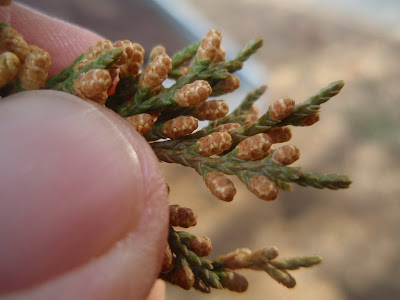Juniperus virginiana; Open for Business
I was preparing for a lecture on gymnosperms for my MST botany class and decided to collect specimens of male strobili from the Juniperus virginiana next to my house. You know, something to pass around, to smell, to feel. Male strobili are easily found. In fact, when in abundance on certain trees they give a tan hue that can be zeroed in on from quite a distance.


I admire these reproductive gems every year and anticipate their awakening as one of the first stirrings of Spring. With spring Peepers chanting in the background, I shook a branch and delighted at the millions of encapsulated microgametophytes lofting on their journeys of hope, each wanting only to contribute its self-determined half to future eastern red cedars everywhere. The assumption of hope being my wish for them and an obvious stray from scientific reasoning that I allowed myself in my hour of appreciation and, dare I say, participation.
But what about the ladies? Those to whose liquid pollination droplets these lusty yellow shore-leave soldiers of sexual selection aspire? Where are they in such a time of need? And why have I never seen them in spite of many a casual attempt at location? I see plenty of female plants as indicated by the previous season’s berry-like fleshy blue cones and I have picked through many branchlets with the intense attention of a bonsai artist, but have always fallen short of discovery. But there I am, year after lonely year, growing more concerned and frustrated by every failed attempt.
Well, I am proud to say that I need look no more. While digging through the dizzying dichotomy of branches and scales, straining my eyes on broken tips that may be it but aren’t while getting pricked by the dry and needle-like scales of the interior, I finally found one.

In full glory, I give you an open megastrobilus of Juniperus virginiana. Notice the three naked ovules two of which have active pollination droplets. These droplets exude from the micropyle and provide increased surface area for pollen grains to land on. Eventually, the droplets contract back into the ovule and bring the pollen in contact with the nucellus of the ovule. A pollen tube extends into each archegonium of the ovule making fertilization possible. If all goes right, a seed forms and awaits dispersal. Notice the thick "scales" surrounding the three ovules. These will develop into the fleshy cone of the glaucous-blue "berries" (hey, my two year old calls them blueberries so back off).
A piece of me is now at rest and I sleep better, undetectably so but better, knowing everything is indeed as it should be. And if I pursue the hunt for the elusive female cones of junipers again, it will be for fun rather than the aching necessity of curiosity.



Excellent inside look at the reproduction system of the Red Cedar! I've never seen what the blue cones look like before they reach maturity. Fun post!
ReplyDeleteThanks! I just visited the "Natural Treasures of Ohio" blog. Great stuff and tremendous photography! I went to grad school in Ohio (Miami) and now look forward to seeing more of what I'm missing from that beautiful state.
ReplyDeleteI appreciate the kind words, it always means a lot! I grew up only an hour away from Miami University and have many friends that have attended there over the years. Hueston Woods was a popular camping spot for me and my friends growing up!
ReplyDeleteA few days ago, while walking in our pasture on a windy day, I saw a billowing yellow cloud erupt numerous times from a stand of red cedars.I felt as if I was witnessing something magical and myterious. I had no idea where the cloud had originated. I just happened along your blog today, myterery solved. I look forward to going back out to take a closer look.
ReplyDeleteI,too, look fotward each spring to the yellow " smoke" of the male cedar. We have a lot of 'em here in Ozarks, and they are a harbinger of the season. Thanks.
ReplyDelete